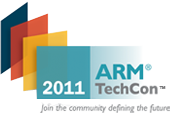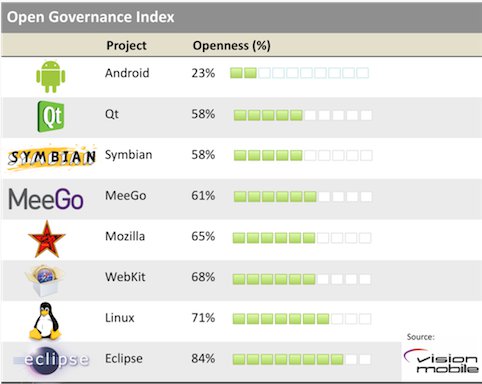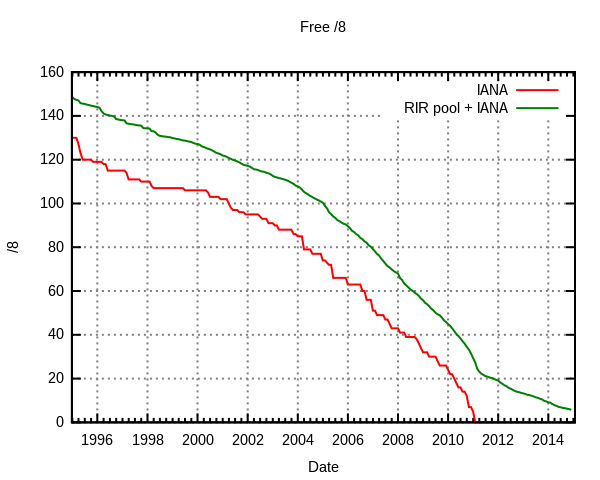ARM Technology Conference (TechCon) 2011 will be hosted in Santa Clara on the 25-27 October 2011. There will be many events and classes related to Chip Design and Software & System Design. The Software & System Design events will take place on the 26th and 27th October 2011. Here’s the schedule for Software & System Design events for the 26th of October: Time Class Track 11 am The 2012 Compute Subsystem Creating Smarter Systems 11 am Practical Cortex Debugging: Serial Wire Viewer and ETM Tracing Developing/Debugging 11 am Integrating a CMOS Imaging Sensor into an ARM-Based Embedded Application Human Interface Design 11 am Embedded IPv6 – Now is the time Networking & Connectivity 11 am RSA & AES Libraries protected against side-channel attacks Safety & Security 11 am Introduction to the ARM Architecture The Fundamentals of ARM 12 pm Optimizing SoC development through a common design foundation Creating Smarter Systems […]
Android Scores Last in Open Governance Index
Vision Mobile recently released a report about different open source projects analyzing their openness via their Open Governance Index. The full report (45-pages) examines: Open source cultural roots and working upstream vs downstream Open source licenses vs governance models Analysis and classification of governance models In-depth reviews of Android, Qt, Symbian, MeeGo, Mozilla, WebKit, Linux and Eclipse Best practices in creating an open source project The governance index is not only based on the percentage of source code that is open, but on the whole software development including the transparency of the decision making-process, the involvement of the community in all aspects of the project, compliance requirements and more. There are a total of 13 metrics accross 4 area of governance: Access: availability of the latest source code, developer support mechanisms, public roadmap, and transparency of decision-making Development: the ability of developers to influence the content and direction of the […]
Yocto Project: Build Your Own Custom Embedded Kernel Image
The Yocto Project is an open source collaboration project that provides templates, tools and methods to help you create custom Linux-based systems for embedded products regardless of the hardware architecture. The first official release (Yocto Project 1.0) has been made available on the 6th of April 2011. Yocto Project Overview See this short video presentation of the Yocto Project which explains its goals. It’s a complete embedded Linux development environment with tools, metadata, and documentation – everything you need such as emulation environments, debuggers, an Application Toolkit Generator, etc… It is not a new build system however such as buildroot, instead it relies on the Poky build tools that provide an open source development environment targeting the ARM, MIPS, PowerPC and x86 architectures. Here’s what the Yocto Project provides: A recent Linux kernel along with a set of system commands and libraries suitable for the embedded environment. System components such […]
Is it IPv6 Time ? IPv6 Basics on Linux
The first time I worked on IPv6 was in 2000 in my master’s degree thesis where I started an implementation of Mobile IP based on IPv6 in Linux Redhat. Over a decade later, IPv6 has not really taken off, even though we hear stories about the IPv4 address space running out and I have yet to see an embedded device using anything else than IPv4. APNIC Ran out of IPv4 However, this may be about the change as on the 15th of April 2011, Japan Network Information Center (JPNIC) announced that APNIC (Asia Pacific Network Information Centre) ran out of IPv4 addresses. They will still try to make it last longer by reusing previously allocated IPv4 and an “IPv4 address transfer system” whose details will be made available later. You can also see a chart based on IANA (Internet Assigned Numbers Authority) data that shows this is a problem right […]
Over 40 Percent of Embedded Projects are Behind Schedule
VDC Research has published a research note entitled “Running Behind Schedule: The Crisis in Software & System Development” where they surveyed some embedded and enterprise developers and got the result that over 40% of developers report their project is behind schedule. The worrying fact is that this issue does not improve over the years. It is interesting to note that the average project takes over a year and involves over 30 full-time software engineers. The four main reasons cited for the delays are: Changes in specifications Complexity of the application Customer changed requirements Lack of manpower VDC explains that in the I.T world many are using Agile to manage changes in specifications, this is not the case in embedded market as every industry has very different requirements. There are specific process requirements for embedded systems, but those have been designed for the Waterfall or V model methods , not interactive […]
Embedded Linux Quick Start / Tutorial Videos
Free Electrons recorded some videos from the Embedded Linux Conference Europe, in Cambrigde, United Kingdom on October 2010 by Chris Simmonds, the founder of 2net Limited, a UK company providing training, consultancy and custom software for Linux and other embedded platforms. The videos can either be downloaded in webm HD format at http://free-electrons.com/blog/elce-2010-tutorial-videos/ or you can watch them in HD format below. The PDF slides for the three parts and the lab notes are available at http://elinux.org/images/c/cc/Linux-quick-start.tar.gz The first video (53 minutes) deals with the following key points: Genesis of a Linux project The four elements: Tool chain; boot loader; kernel; user space Element 1: Tool chain Element 2: Boot loader The second video (1h19m) focuses on: Third element: Kernel Fourth element: User space The last video (1h07m) is more practical as it shows how to use embedded Linux on an NXP LPC3250 Stick (ARM9): Description of the hardware Installing […]
Cross compiling SQLite for ARM and MIPS
Following my blog entry about Databases for Linux Embedded Systems, here are the instructions to cross-compile SQlite. First download the latest version of SQLite amalgamation with autoconf script (version 3.75): wget http://www.sqlite.org/sqlite-autoconf-3070500.tar.gz Extract the source code: tar xzvf sqlite-autoconf-3070500.tar.gz Configure and build the source code. I’ll use mipsel-linux-gcc, but any other cross-compiler could be used. cd sqlite-autoconf-3070500 ./configure –host=mipsel-linux –target=mipsel-linux –prefix=/home/jaufranc/edev/sqlite-mips make make install At this point the library is correctly configured and installed, so you’d just need to copy the relevant files to your target board (skip include and share directories and libsqlite3.a) . Let’s check the size of the required files: ls -l ../sqlite-mips/bin/ -rwxr-xr-x 1 jaufranc jaufranc 125513 2011-03-14 14:21 sqlite ls -l ../sqlite-mips/lib/libsqlite3.so.0.8.6 -rwxr-xr-x 1 jaufranc jaufranc 2087584 2011-03-14 14:21 ../sqlite-mips/lib/libsqlite3.so.0.8.6 sqlite binary is 122.57KB and the dynamic library 2038.65KB. Let’s see if we can optimize the binary size with compilation flags and by disabling some […]
HbbTV: Hybrid Broadcast Broadband TV
HbbTV (Hybrid Broadcast Broadband TV) is a new European standard for web-based smart TV applications for TVs and set-top boxes. Services and applications delivered via HbbTV include traditional broadcast TV channels, catch-up services, video-on-demand, EPG, interactive advertising, personalisation, voting, games, social networking and other multimedia applications. The latest version of the HbbTV specification is 1.1.1 and can normally be downloaded after registering on ETSI website. The official nomenclature of the specification is ETSI TS 102 796. It is also directly available at the following link – http://www.etsi.org/deliver/etsi_ts/102700_102799/102796/01.01.01_60/ts_102796v010101p.pdf The HbbTV specification is based on existing standards and web technologies including OIPF (Open IPTV Forum), CEA, DVB and W3C. HbbTV Specifications specifically makes use of the following standards: CEA-2014 – Web-based Protocol and Framework for Remote User Interface on UPnP Networks and the Internet (Web4CE), also known as CE-HTML. Open IPTV Forum Release 1 Volume 5 – Declarative Application Environment of the […]








